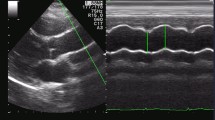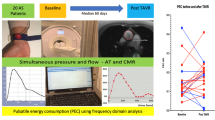Abstract
We investigated the impact of continuous-flow left ventricular assist devices (LVAD) on the carotid elastic properties. Carotid artery parameters (diameter distensibility (DD), cross-sectional distensibility (CSD), diameter compliance (DC), cross-sectional compliance (CSC), and incremental elastic modulus (IEM)) were measured in a cross-sectional study using a standard ultrasound with a 10-MHz linear array probe. Measurements (mean ± SEM) were made in separate groups at various clinical time points: prior to LVAD surgery (baseline; 13 male/3 female; age 48 ± 3 years), 1 week following LVAD placement (acute; 12 male/2 female; age 47 ± 3 years), approximately 24 weeks following LVAD surgery (chronic; 13 male/2 female; age 52 ± 3 years), and in a group of healthy subjects (controls; 9 male/1 female; age 51 ± 4 years). Distensibility properties were lower (P < 0.05) in the acute (DD 2.3 % ± 0.4 %; CSD 4.7 % ± 0.8 %) and chronic (DD 2.2 % ± 0.4 %; CSD 4.5 ± 0.9 %) compared with the baseline (DD 5.9 % ± 0.7 %; CSD 12.2 % ± 1.5 %) and control (DD 5.8 % ± 0.6 %; CSD 11.9 % ± 1.3 %) groups. Compliance properties were lower (P < 0.05) in the chronic (DC 4.4 ± 0.7 mm/mmHg × 10−3; CSC 1.2 ± 0.2 mmHg−1 × 10−3) compared with acute (DC 9.0 ± 1.6 mm/mmHg × 10−3; CSC 2.6 ± 0.4 mmHg−1 × 10−3) and baseline (DC 11.1 ± 1.1 mm/mmHg × 10−3; CSC 3.3 ± 0.4 mmHg−1 × 10−3) groups. The compliance properties in the control (DC 8.3 ± 0.8 mm/mmHg × 10−3; CSC 2.4 ± 0.2 mmHg−1 × 10−3) group were not different from any of the patient groups. The IEM was higher (P < 0.05) in the chronic (6908 ± 1269 mmHg) compared with acute (2739 ± 412 mmHg), baseline (1849 ± 177 mmHg), and control (2349 ± 241 mmHg) groups. Chronic continuous-flow LVAD support is associated with lower carotid artery compliance and distensibility, which may place further strain on the left ventricle.




Similar content being viewed by others
References
Liu J, Cao TS, Duan YY, Yang YL, Yuan LJ (2011) Effects of cold pressor-induced sympathetic stimulation on the mechanical properties of common carotid and femoral arteries in healthy males. Heart Vessels 26(2):214–221
Reneman R, Meinders J, Hoeks APG (2005) Non-invasive ultrasound in arterial wall dynamics in humans: what have we learned and what remains to be solved. Eur Heart J 26(10):960–966
Olinic D, Olinic M, Laza S, Lenta D, Anton F, Albu C, Olinic N (2003) Arterial compliance in hypertension and heart failure. Rom J Intern Med 41(2):113–124
Liao D, Arnett DK, Tyroler HA, Riley WA, Chambless LE, Szklo M, Heiss G (1999) Arterial stiffness and the development of hypertension. The ARIC study. Hypertension 34(2):201–206
van Popele NM, Grobbee DE, Bots ML, Asmar R, Topouchian J, Reneman RS, Hoeks AP, van der Kuip DA, Hofman A, Witteman JC (2001) Association between arterial stiffness and atherosclerosis: the Rotterdam study. Stroke 32(2):454–460
Triantafyllidi H, Rizos I, Rallidis L, Tsikrikas S, Triantafyllis A, Ikonomidis I, Panou F, Rigopoulos A, Kremastinos DT (2010) Aortic distensibility associates with increased ascending thoracic aorta diameter and left ventricular diastolic dysfunction in patients with coronary artery ectasia. Heart Vessels 25(3):187–194
Pierdomenico SD, Mancini M, Cuccurullo C, Guglielmi MD, Pierdomenico AM, Di Nicola M, Di Carlo S, Lapenna D, Cuccurullo F (2012) Prediction of carotid plaques in hypertensive patients by risk factors, left ventricular hypertrophy, and epicardial adipose tissue thickness. Heart Vessels
O’Rourke M (1995) Mechanical principles in arterial disease. Hypertension 26(1):2–9
Laurent S, Cockcroft J, Van Bortel L, Boutouyrie P, Giannattasio C, Hayoz D, Pannier B, Vlachopoulos C, Wilkinson I, Struijker-Boudier H (2006) Expert consensus document on arterial stiffness: methodological issues and clinical applications. Eur Heart J 27(21):2588–2605
Lage SG, Kopel L, Monachini MC, Medeiros CJ, Pileggi F, Polak JF, Creager MA (1994) Carotid arterial compliance in patients with congestive heart failure secondary to idiopathic dilated cardiomyopathy. Am J Cardiol 74(7):691–695
Badran H, Mostafa A, Serage A, Fareed W, Abdelfatah E, Fathe A (2009) Arterial mechanics in ischemic versus nonischemic cardiomyopathy: clinical and diagnostic impact. Echocardiography 26(7):785–800
Jarcho J, Fang J (2005) Recent advances in cardiac allotransplantation. In: Fang J, Couper G (eds) Surgical management of congestive heart failure. Humana Press, Totowa, p 1
Argenziano M, Michler RE, Rose EA (1997) Cardiac transplantation for endstage heart disease. Heart Vessels Suppl 12:23–27
Hoffman FM (2005) Outcomes and complications after heart transplantation: a review. JCN 20(5 Suppl):S31–S42
Patel A, Kuvin J, Pandian N, Smith J, Udelson J, Mendelsohn M, Konstam M, Karas R (2001) Heart failure etiology affects peripheral vascular endothelial function after cardiac transplantation. JACC 37(1):195–200
Zimmer R, Lee M (2010) Transplant coronary artery disease. JACC Cardiovasc Interv 3(4):367–377
Schmidt A, Pleiner J, Bayerle-Eder M, Wiesinger G, Rodler S, Quittan M, Mayer G, Wolzt M (2002) Regular physical exercise improves endothelial function in heart transplant recipients. Clin Transplant 16:137 (Journal Article)
Entwistle JC (2004) Short- and long-term mechanical ventricular assistance towards myocardial recovery. Surg Clin North Am 84(1):201–221
DiGiorgi P, Naka Y, Oz M (2005) Left ventricular assist devices. In: Fang J, Couper G (eds) Surgical management of congestive heart failure. Humana Press, Totowa, p 155
Radovancevic B, Vrtovec B, deKort E, Radovancevic R, Gregoric I, Frazier OH (2007) End-organ function in patients on long-term circulatory support with continuous- or pulsatile-flow assist devices. J Heart Lung Transplant 26(8):815–818
Takami Y, Otsuka G, Mueller J, Ohashi Y, Tayama E, Schima H, Schmallegger H, Wolner E, Nose Y (1997) Flow characteristics and required control algorithm of an implantable centrifugal left ventricular assist device. Heart Vessels 12(2):92–97
Taketani S, Sawa Y, Fukushima N, Masai T, Kawaguchi N, Onishi S, Matsuda H (1997) Myocardial histological changes in dilated cardiomyopathy during a long-term left ventricular assist device support. Heart Vessels 12(2):98–100
Nguyen TN, Hu D, Kim M-H, Grines CL (eds) (2007) Management of complex cardiovascular problems: the evidence-based medicine approach, vol. 3. Blackwell Futura, Boston
Celermajer DS, Sorensen KE, Gooch VM, Spiegelhalter DJ, Miller OI, Sullivan ID, Lloyd JK, Deanfield JE (1992) Non-invasive detection of endothelial dysfunction in children and adults at risk of atherosclerosis. Lancet 340(8828):1111–1115
Anderson TJ, Uehata A, Gerhard MD, Meredith IT, Knab S, Delagrange D, Lieberman EH, Ganz P, Creager MA, Yeung AC (1995) Close relation of endothelial function in the human coronary and peripheral circulations. J Am Coll Cardiol 26(5):1235–1241
Shah A, Gkaliagkousi E, Ritter J, Ferro A (2010) Endothelial function and arterial compliance are not impaired in subjects with heart failure of non-ischemic origin. J Card Fail 16(2):114–120
Loizou CP, Pantziaris M, Pattichis MS, Kyriacou E, Pattichis CS (2009) Ultrasound image texture analysis of the intima and media layers of the common carotid artery and its correlation with age and gender. Comput Med Imaging Graph 33(4):317–324
Aminbakhsh A, Mancini GB (1999) Carotid intima-media thickness measurements: what defines an abnormality? A systematic review. Clin Invest Med 22(4):149–157
Simon A, Gariepy J, Chironi G, Megnien J-L, Levenson J (2002) Intima–media thickness: a new tool for diagnosis and treatment of cardiovascular risk. J Hypertens 20(2):159–169
Cervini P, Park SJ, Shah DK, Penev IE, Lewis BD (2010) Carotid Doppler ultrasound findings in patients with left ventricular assist devices. Ultrasound Q 26(4):255–261
Reneman RS, van Merode T, Hick P, Muytjens AM, Hoeks AP (1986) Age-related changes in carotid artery wall properties in men. Ultrasound Med Biol 12(6):465–471
Kawasaki T, Sasayama S, Yagi S, Asakawa T, Hirai T (1987) Non-invasive assessment of the age related changes in stiffness of major branches of the human arteries. Cardiovasc Res 21(9):678–687
Tomiyama H, Yamashina A (2010) Non-invasive vascular function tests: their pathophysiological background and clinical application. Circ J 74(1):24–33
Papaioannou TG, Mathioulakis DS, Tsangaris SG (2003) Simulation of systolic and diastolic left ventricular dysfunction in a mock circulation: the effect of arterial compliance. J Med Eng Technol 27(2):85–89
Stewart AS, Russo MJ, Martens TP, Naseem TM, Deng MC, Wang R, Argenziano M, Oz M, Naka Y (2008) Longer duration of continuous-flow ventricular assist device support predicts greater hemodynamic compromise after return of pulsatility. J Thorac Cardiovasc Surg 136(2):524–525
Amir O, Radovancevic B, DelgadoIii R, Kar B, Radovancevic R, Henderson M, Cohn W, Smart F (2006) Peripheral vascular reactivity in patients with pulsatile vs axial flow left ventricular assist device support. J Heart Lung Transplant 25(4):391–394
Author information
Authors and Affiliations
Corresponding author
Rights and permissions
About this article
Cite this article
Templeton, D.L., John, R., Painter, P. et al. Effects of the left ventricular assist device on the compliance and distensibility of the carotid artery. Heart Vessels 28, 377–384 (2013). https://doi.org/10.1007/s00380-012-0271-4
Received:
Accepted:
Published:
Issue Date:
DOI: https://doi.org/10.1007/s00380-012-0271-4




